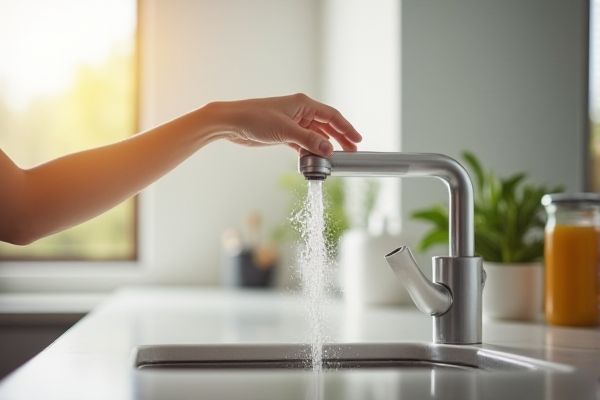
Touchless soap dispensers offer enhanced hygiene by reducing contact with surfaces, minimizing the spread of germs, and providing convenience with sensor-activated dispensing. Compare the benefits of touchless soap dispensers versus manual dispensers to determine which fits your needs best, and discover more insights in the rest of the article.
Table of Comparison
| Feature | Touchless Soap Dispenser | Manual Soap Dispenser |
|---|---|---|
| Operation | Automatic sensor-activated, no hand contact | Requires manual pressing or pumping |
| Hygiene | Reduces cross-contamination and germ spread | Higher risk of contamination via shared contact |
| Power Source | Batteries or rechargeable | No power needed |
| Installation | Requires power access, slight setup complexity | Simple wall-mounted or countertop placement |
| Maintenance | Sensor calibration and battery replacement needed | Minimal, mostly refilling soap |
| Cost | Higher initial investment | Lower cost, budget-friendly |
| Soap Dispensing Control | Consistent and measured dispensing volume | Varies by user effort and dispenser design |
Introduction to Soap Dispensers
Touchless soap dispensers use infrared sensors to detect your hand and automatically release soap, enhancing hygiene by minimizing contact with surfaces. Manual soap dispensers require you to press a pump, which can transfer germs and often demands more frequent cleaning. Choosing a touchless option helps maintain cleanliness and provides a more convenient, modern experience.
Overview of Touchless Soap Dispensers
Touchless soap dispensers utilize infrared sensors to detect hand presence and dispense soap automatically, reducing physical contact and minimizing the spread of germs. These devices are commonly equipped with rechargeable batteries or can be connected to power sources, offering convenience and hygiene in public and private settings. Compared to manual dispensers, touchless models enhance user experience by promoting hands-free operation and ensuring more consistent soap usage.
Overview of Manual Soap Dispensers
Manual soap dispensers rely on physical pumps that require users to press a lever or button, making them straightforward and cost-effective for everyday use. These dispensers are widely used in homes and public restrooms, offering durability and ease of maintenance without the need for batteries or sensors. Despite their simplicity, manual dispensers can contribute to cross-contamination, as multiple users touch the same surface.
Hygiene and Health Benefits Comparison
Touchless soap dispensers significantly reduce the risk of cross-contamination by eliminating direct contact, making them more hygienic than manual dispensers, which can harbor bacteria on their surfaces. Studies show that touchless systems lower the spread of pathogens in high-traffic areas like hospitals and restaurants, contributing to improved public health. Manual dispensers, while cost-effective, require frequent cleaning and maintenance to maintain similar hygiene standards.
Ease of Use and Accessibility
Touchless soap dispensers offer superior ease of use by eliminating the need for physical contact, making them highly accessible for individuals with limited mobility or dexterity challenges. Manual dispensers require pressing or pumping, which can be difficult for users with arthritis or hand strength issues. The sensor-activated operation of touchless dispensers promotes hygiene while ensuring seamless accessibility for all users in both home and public settings.
Maintenance and Refilling Requirements
Touchless soap dispensers require regular battery replacement and sensor cleaning to maintain optimal functionality, while manual dispensers need consistent manual refilling and occasional pump lubrication to prevent clogging. The automatic mechanism in touchless models reduces the risk of cross-contamination but often involves more complex maintenance procedures. Manual soap dispensers offer simpler and more cost-effective upkeep, but frequent high-touch use can increase wear and require more frequent refill checks.
Cost and Long-term Value
Touchless soap dispensers typically have a higher upfront cost due to built-in sensors and battery-operated mechanisms, whereas manual dispensers are more affordable initially. Over time, touchless models can reduce soap waste and minimize the spread of germs, offering better hygiene and potential savings on refills. Manual dispensers may require less maintenance but often result in higher soap usage and recurring costs.
Environmental Impact Assessment
Touchless soap dispensers reduce water and soap waste by delivering precise amounts, minimizing environmental pollution compared to manual dispensers, which often lead to excess usage. Battery-operated sensors in touchless models consume electricity, but energy-efficient designs and rechargeable options lower overall carbon footprint. Your choice influences resource consumption, with touchless options offering a more sustainable solution for reducing environmental impact.
Aesthetic and Space Considerations
Touchless soap dispensers offer a sleek, modern design that enhances the aesthetic of any bathroom or kitchen while minimizing clutter, as their compact, wall-mounted options save valuable counter space. Manual dispensers often require more room due to bulkier, freestanding designs that can disrupt the clean lines of your decor. Choosing a touchless dispenser elevates both style and functionality, making it an ideal solution for maximizing space without sacrificing visual appeal.
Which Soap Dispenser is Best for Your Needs?
Touchless soap dispensers offer hygiene benefits by minimizing contact and reducing germ spread, making them ideal for high-traffic or shared spaces. Manual dispensers provide a more cost-effective option with simpler maintenance, suitable for low-traffic areas or budget-conscious users. Your choice depends on prioritizing convenience and cleanliness versus affordability and ease of use.
 homyna.com
homyna.com